air condition OLDSMOBILE SILHOUETTE 1996 Owners Manual
[x] Cancel search | Manufacturer: OLDSMOBILE, Model Year: 1996, Model line: SILHOUETTE, Model: OLDSMOBILE SILHOUETTE 1996Pages: 372, PDF Size: 19.39 MB
Page 142 of 372

I NOTICE:
If you keep driving your vehicle with this light
on, after a while, your emission controls may not
work as well, your fuel economy may not be
as
good and your engine may not run as smoothly.
This could lead to costly repairs that may not be
covered by your warranty.
This light should come on, as a check to show you it is
working, when the ignition is on and the engine is not
running. If the light doesn’t come on, have
it repaired.
This light will also come on during
a malfunction in one
of two ways:
0
0
Light Flashing -- A misfire condition has been
detected. A misfire increases vehicle emissions and
may damage the emission control system
on your
vehicle. Retailer or qualified service center diagnosis
and service is required.
Light On Steady -- An emission control system
malfunction has been detected on your vehicle.
Retailer or qualified service center diagnosis and
service may be required. The
following
may prevent more serious damage to
your vehicle:
0 Reduce vehicle speed.
0 Avoid hard accelerations.
0 Avoid steep uphill grades.
0 If towing a trailer, reduce the amount of cargo being
hauled as soon
as it is possible.
If the light stops flashing and remains on steady, see “If
the Light
Is On Steady” following.
If the light continues to flash, when it is safe to do so,
stop the vehicle. Put your vehicle in PARK (P). Turn the
key off, wait at least 10 seconds and restart the engine.
If the light remains on steady, see
“If the Light Is On
Steady” following.
If the light is still flashing follow the
previous steps, and drive the vehicle to your retailer
or
qualified service center for service.
ProCarManuals.com
Page 143 of 372
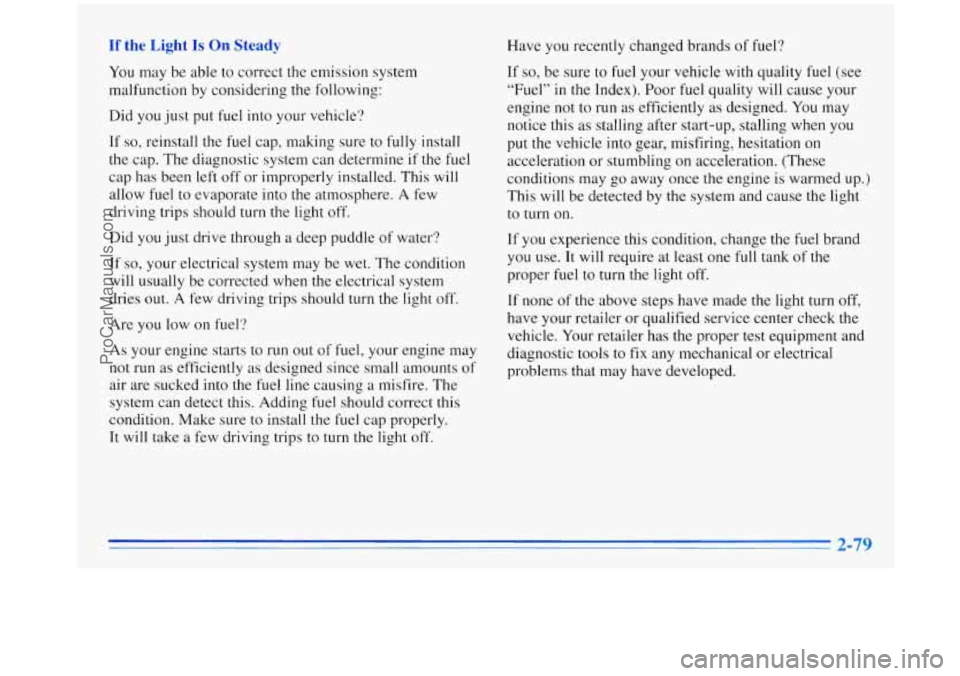
If 3 Light Is On Steady
IOU may be able to correct the emission system
malfunction by considering the following:
Did you just put fuel into your vehicle?
If
so, reinstall the fuel cap, making sure to fully install
the cap. The diagnostic system
can determine if the fuel
cap has been
left off or improperly installed. This will
allow fuel to evaporate into the atmosphere.
A few
driving trips should turn the light off.
Did you just drive through a deep puddle of water?
If
so, your electrical system may be wet. The condition
will usually be corrected when the electrical system
dries out. A few driving trips should turn the light off.
Are you low on fuel?
As your engine starts to run out of fuel, your engine may
not run as efficiently
as designed since small amounts of
air are sucked into the fuel line causing a misfire. The
system can detect this. Adding fuel should correct this
condition. Make sure
to install the fuel cap properly.
It will take
a few driving trips to turn the light off. Have
you recently changed brands of fuel?
If
so, be sure to fuel your vehicle with quality fuel (see
“Fuel”
in the Index). Poor fuel quality will cause your
engine not to run as efficiently
as designed. You may
notice this
as stalling after start-up, stalling when you
put the vehicle into gear, misfiring, hesitation on
acceleration or stumbling on acceleration. (These
conditions may go away once the engine is warmed up.)
This will be detected by the system and cause the light
to turn on.
If you experience this condition, change the fuel brand
you use. It will require at least one full tank of the
proper fuel to turn the light off.
If none of the above steps have made the light turn off,
have your retailer or qualified service center check the
vehicle. Your retailer has the proper test equipment and
diagnostic tools to fix any mechanical or electrical
problems that may have developed.
ProCarManuals.com
Page 149 of 372
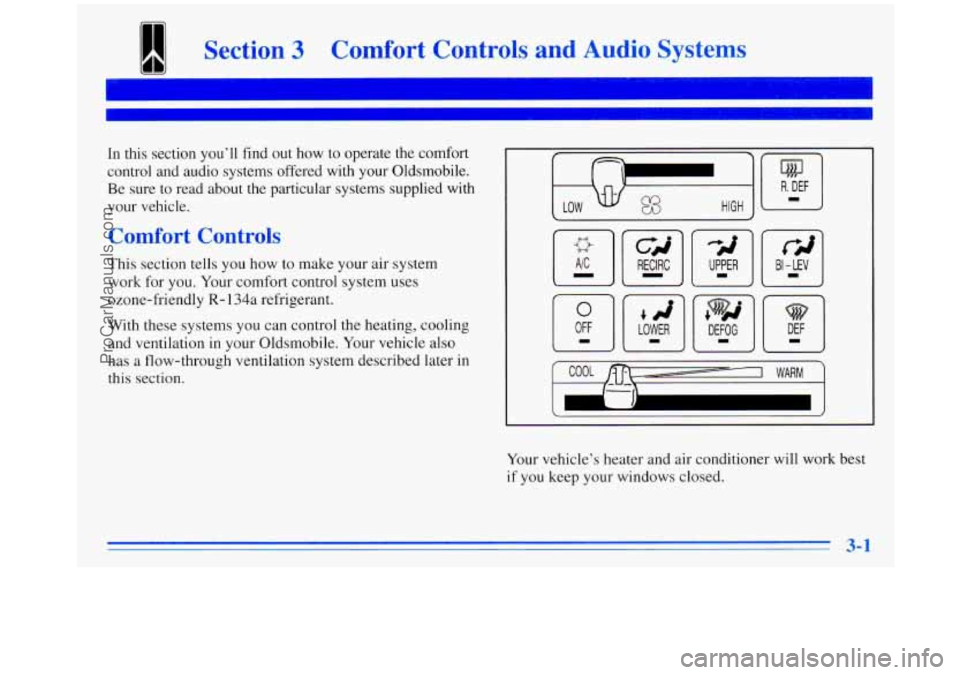
Section 3 Comfort Controls and Audio Systems
In this section you’ll find out how to operate the comfort
control and audio systems offered with your Oldsmobile.
Be sure
to read about the particular systems supplied with
your vehicle.
Comfort Controls
This section tells you how to make your air system
work for you. Your comfort control system uses
ozone-friendly
R- 134a refrigerant.
With these systems you can control the heating, cooling
and ventilation in your Oldsmobile. Your vehicle also
has a flow-through ventilation system described later in
this section.
rii
BI - LEV I
Your vehicle’s heater and air conditioner will work best
if you keep your windows closed.
3-1
ProCarManuals.com
Page 150 of 372
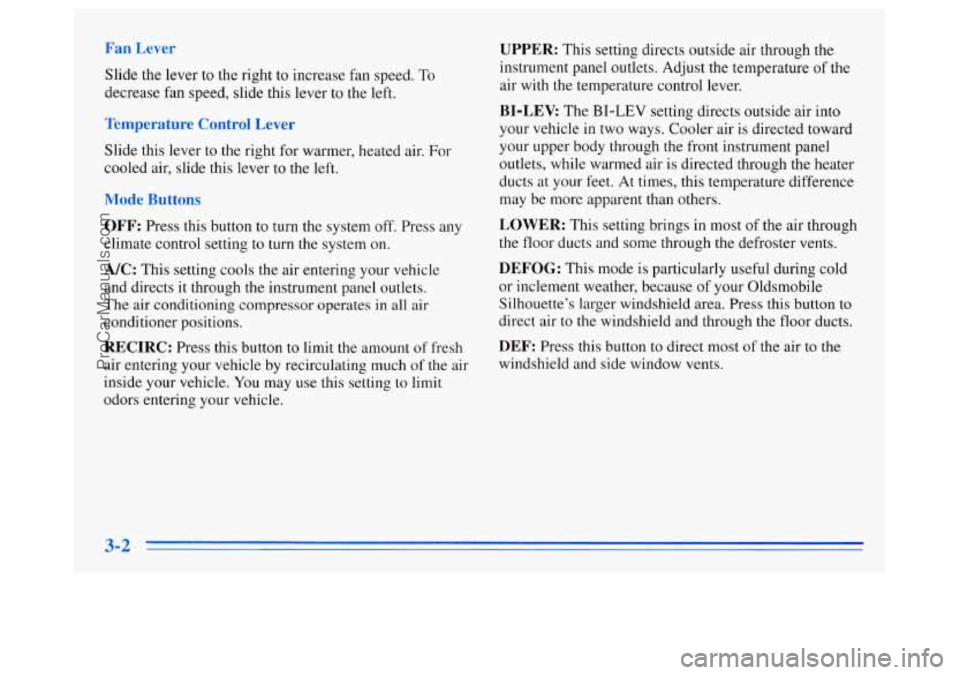
Slide the lever to the right to increase fan speed. To
decrease fan speed, slide this lever to the left.
I 1 *_I.
Slide this lever to the right for warmer, heated air. For
cooled air, slide this lever to the left.
Mode B.
OFF: Press this button to turn the system off. Press any
climate control setting to turn the system
on.
A/C: This setting cools the air entering your vehicle
and directs it through the instrument panel outlets.
The air conditioning compressor operates
in all air
conditioner positions.
RECIRC: Press this button to limit the amount of fresh
air entering your vehicle by recirculating much
of the air
inside your vehicle.
You may use this setting to limit
odors entering your vehicle.
UPPER: This setting directs outside air through the
instrument panel outlets. Adjust the temperature of the
air with the temperature control lever.
BI-LEV: The BI-LEV setting directs outside air into
your vehicle
in two ways. Cooler air is directed toward
your upper body through the front instrument panel
outlets, while warmed air is directed through the heater
ducts at your feet. At times, this temperature difference
may be more apparent than others.
LOWER: This setting brings in most of the air through
the floor ducts and some through the defroster vents.
DEFOG: This mode is particularly useful during cola
or inclement weather, because of your Oldsmobile
Silhouette’s larger windshield area. Press this button to
direct air to the windshield and through the floor ducts.
DEF: Press this button to direct most of the air to the
windshield and side window vents.
3-2
ProCarManuals.com
Page 151 of 372
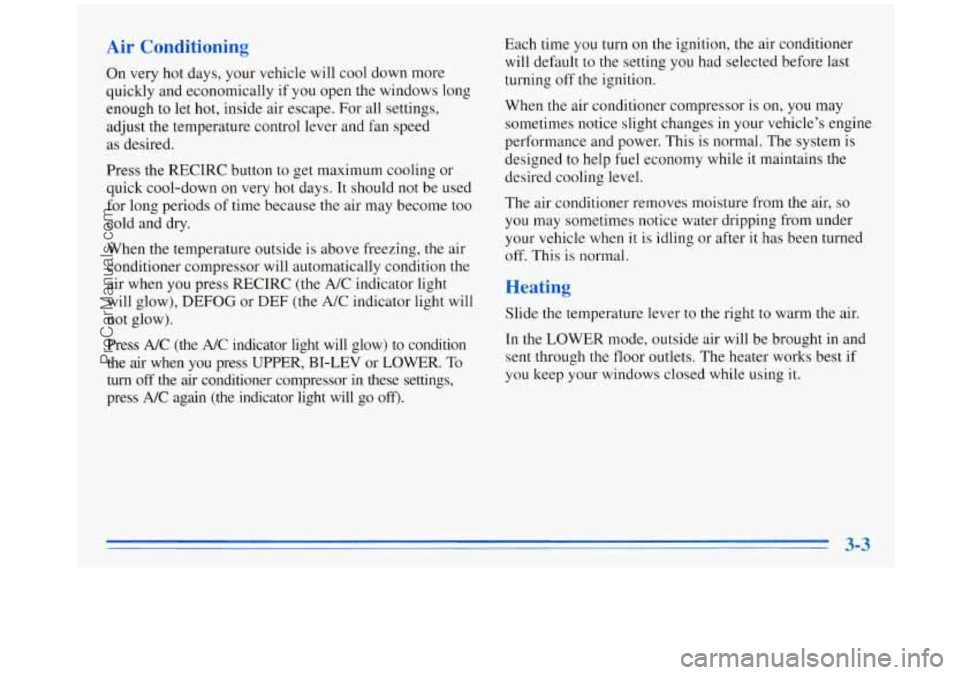
On very hot days, your vehicle will cool down more
quickly and economically if you open the windows long
enough to let
hot, inside air escape. For all settings,
adjust the temperature control lever and fan speed
as desired.
Press the RECIRC button
to get maximum cooling or
quick cool-down on very hot days. It should not be used
for long periods of time because the air may become too
cold and dry.
When the temperature outside is above freezing,
the air
conditioner compressor will automatically condition the
air when you press RECIRC (the A/C indicator light
will glow),
DEFOG or DEF (the A/C indicator light will
not glow).
Press A/C (the
A/C indicator light will glow) to condition
the air when you press UPPER, BI-LEV or LOWER. To
turn
off the air conditioner compressor in these settings,
press A/C again (the indicator light will go
off>.
Each time you turn on the ignition, the air conditioner
will default to the setting you had selected before last
turning off the ignition.
When the air conditioner compressor is on,
you may
sometimes notice slight changes
in your vehicle’s engine
performance and power. This is normal. The system
is
designed to help fuel economy while it maintains the
desired cooling level.
The air conditioner removes moisture from the air,
so
you may sometimes notice water dripping from under
your vehicle when
it is idling or after it has been turned
off. This is normal.
T’
Slide the temperature lever to the right to warm the air.
In the LOWER mode, outside air will be brought
in and
sent through
the floor outlets. The heater works best if
you keep your windows closed while using
it.
ProCarManuals.com
Page 152 of 372
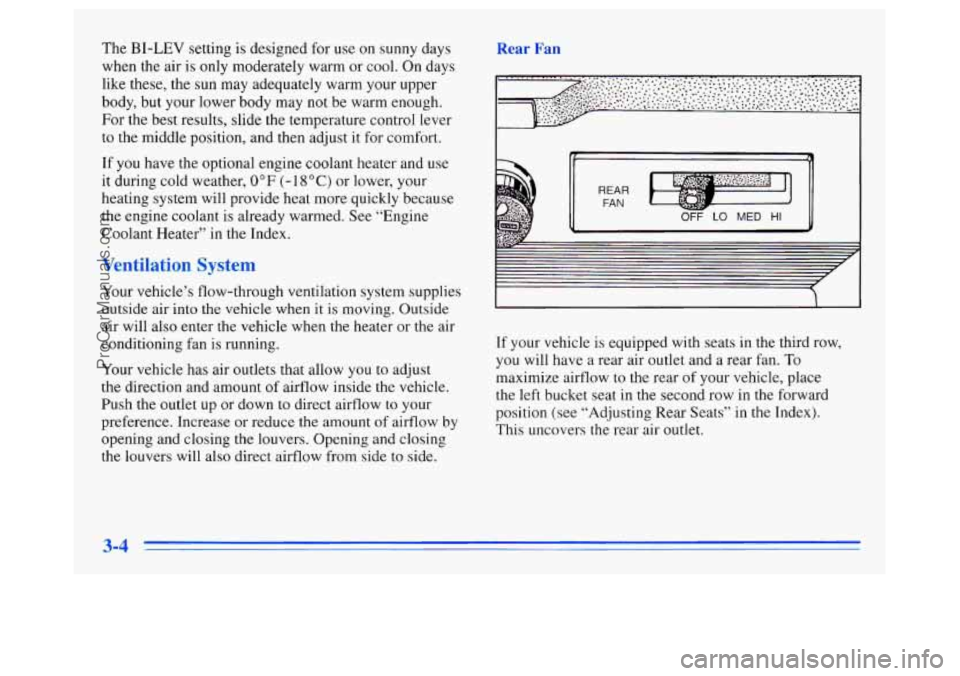
The BI-LEV setting is designed for use on sunny days
when the air is
only moderately warm or cool. On days
like these, the sun may adequately warm your upper
body, but your lower body may not be warm enough.
For the best results, slide the temperature control lever
to the middle position, and then adjust it for comfort.
If you have the optional engine coolant heater and use
it during cold weather,
0°F (-18°C) or lower, your
heating system will provide heat more quickly because
the engine coolant is already warmed. See “Engine
Coolant Heater’’
in the Index.
%til-.tion Syst
Your vehicle’s flow-through ventilation system supplies
outside air
into the vehicle when it is moving. Outside
air will also enter the vehicle when the heater or the air
conditioning fan is running.
Your vehicle has air outlets that allow you to adjust
the direction and amount
of airflow inside the vehicle.
Push the outlet up or down to direct airflow to your
preference. Increase or reduce the amount
of airflow by
opening and closing the louvers. Opening and closing
the louvers will also direct airflow from side to side.
If your vehicle is equipped with seats in the third row,
you will have a rear air outlet and a rear fan.
To
maximize airflow to the rear of your vehicle, place
the
left bucket seat in the second row in the forward
position (see “Adjusting Rear Seats” in
the Index).
This uncovers the rear air outlet.
ProCarManuals.com
Page 154 of 372
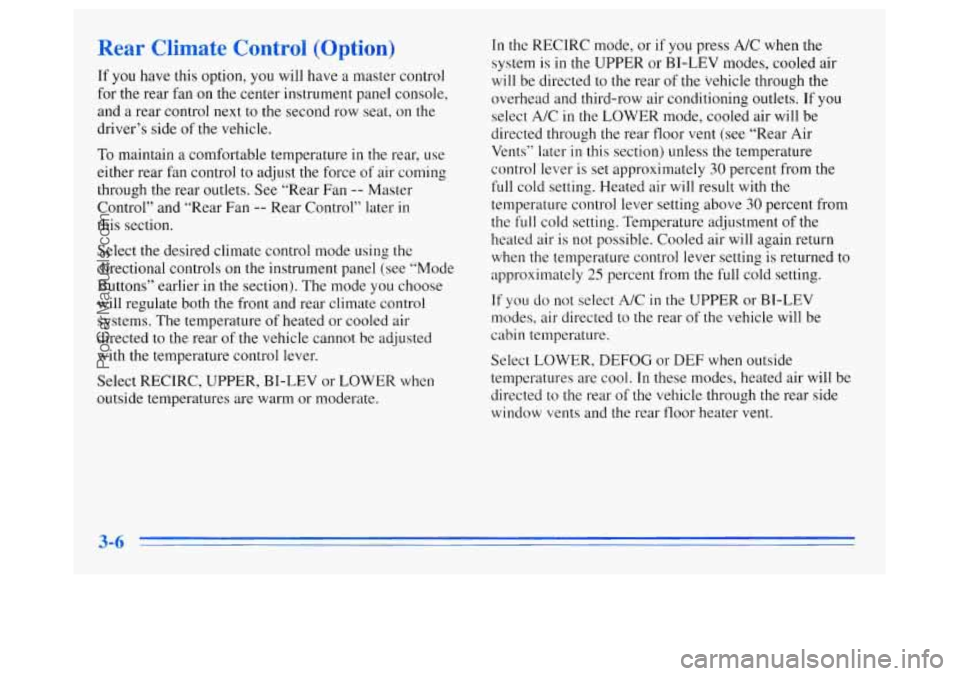
2tion,
If you have this option, you will have a master control
for the rear fan
on the center instrument panel console,
and a rear control next to
the second row seat, on the
driver’s side
of the vehicle.
To maintain a comfortable temperature in the rear, use
either rear
fan control to adjust the force of air coming
through the rear outlets. See “Rear Fan
-- Master
Control” and “Rear Fan
-- Rear Control” later in
this section.
Select the desired climate control mode using the
directional controls on the instrument panel (see “Mode
Buttons” earlier in the section). The mode you choose
will regulate both the front and rear climate control
systems.
The temperature of heated or cooled air
directed to the rear of the vehicle cannot be adjusted
with the temperature control lever.
Select RECIRC, UPPER,
BI-LEV or LOWER when
outside temperatures are warm or moderate. In the
RECIRC mode, or if you press A/C when the
system is in the
UPPER or BI-LEV modes, cooled air
will be directed to the rear of the vehicle through the
overhead and third-row air conditioning outlets. If you
select A/C in the LOWER mode, cooled air
will be
directed through the rear floor vent (see “Rear Air
Vents” later
in this section) unless the temperature
control lever is set approximately
30 percent from the
full cold setting. Heated air will result with the
temperature control lever setting above
30 percent from
the
full cold setting. Temperature adjustment of the
heated air is not possible. Cooled air will again return
when the temperature control lever setting is returned to
approximately
25 percent from the full cold setting.
If you do not select A/C in the UPPER or BI-LEV
modes, air directed to the rear of the vehicle will be
cabin temperature.
Select LOWER, DEFOG or
DEF when outside
temperatures are cool. In these modes, heated air will be
directed to the rear of the vehicle through the rear side
window vents and the rear
floor heater vent.
3-6
ProCarManuals.com
Page 156 of 372
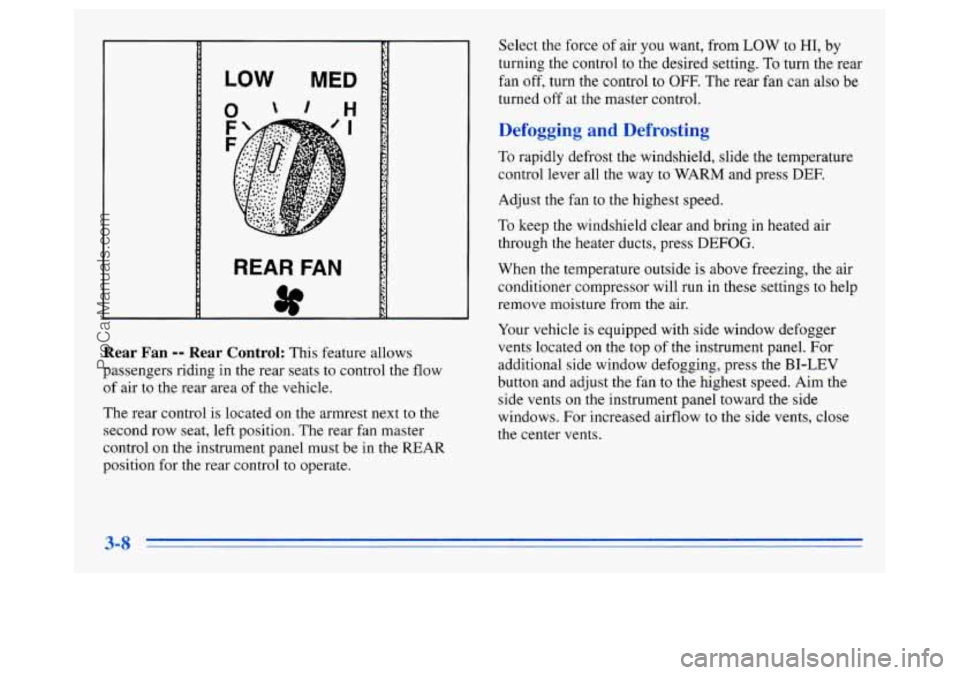
LOW MED I
REAR FAN
Rear Fan -- Rear Control: This feature allows
passengers riding in the rear seats to control the flow
of air to the rear area of the vehicle.
The rear control is located
on the armrest next to the
second row seat, left position. The rear fan master
control on the instrument panel must be
in the REAR
position for the rear control to operate. Select the force
of air you want, from
LOW to HI, by
turning the control to the desired setting. To 'turn
the rear
fan
off, turn the control to OFF. The rear fan can also be
turned off at the master control.
Defogging and Defrosting
To rapidly defrost the windshield, slide the temperature
control lever all the way to WARM and press DEE
Adjust the fan to
the highest speed.
To keep the windshield clear and bring in heated air
through the heater ducts, press DEFOG.
When the temperature outside is above freezing, the air
conditioner compressor will run in these settings
to help
remove moisture from the air.
Your vehicle is equipped with side window defogger
vents located on the top of the instrument panel. For
additional side window defogging, press the
BI-LEV
button and adjust the fan to the highest speed. Aim the
side vents on the instrument panel toward the side
windows. For increased airflow to the side vents, close
the center vents.
3-8
ProCarManuals.com
Page 187 of 372
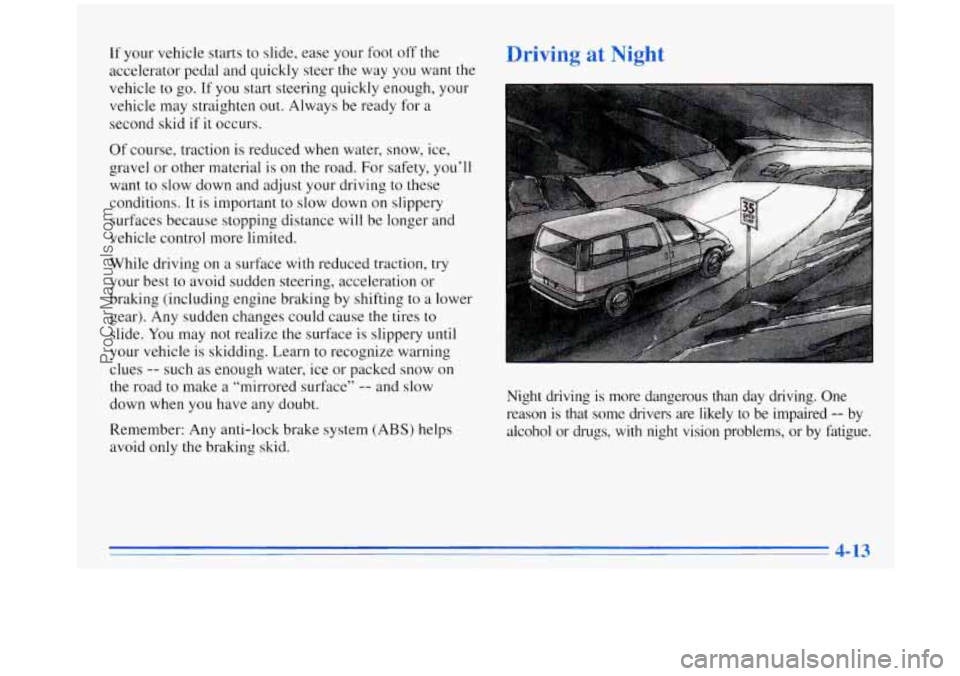
If your vehicle starts to slide, ease your foot off the
accelerator pedal and quickly steer the way you want the
vehicle to go. If you start steering quickly enough, your
vehicle may straighten out. Always be ready for a
second skid
if it occurs.
Of course, traction is reduced when water, snow, ice,
gravel
or other material is on the road. For safety, you’ll
want to slow down and adjust your driving to these
conditions. It is important to slow down on slippery
surfaces because stopping distance
will be longer and
vehicle control more limited.
While driving on a surface with reduced traction, try
your best
to avoid sudden steering, acceleration or
braking (including engine braking by shifting to
a lower
gear). Any sudden changes could cause the tires to
slide. You may not realize the surface is slippery until
your vehicle is skidding. Learn to recognize warning
clues
-- such as enough water, ice or packed snow on
the road to make a “mirrored surface’’ -- and slow
down when
you have any doubt.
Remember: Any anti-lock brake system
(ABS) helps
avoid only the braking skid.
Driving at Night
Night driving is more dangerous than day driving. One
reason
is that some drivers are likely to be impaired -- by
alcohol or drugs, with night vision problems, or by fatigue.
% 4-13
ProCarManuals.com
Page 225 of 372
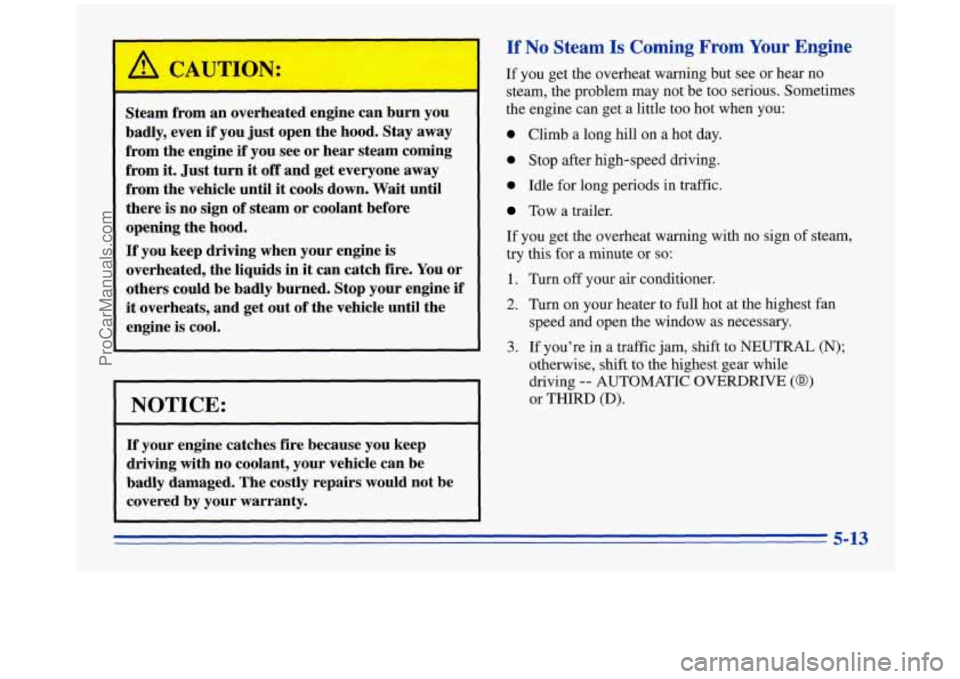
/11 CA JTILV:
Steam from an overheated engine can burn you
badly, even if you just open the hood. Stay away
from the engine
if you see or hear steam coming
from it. Just turn
it off and get everyone away
from the vehicle until it cools down. Wait until
there is no sign of steam or coolant before
opening the hood.
If you keep driving when your engine is
overheated, the liquids
in it can catch fire. You or
others could be badly burned. Stop your engine if
it overheats, and get out of the vehicle until the
engine is cool.
I NOTICE:
r
~ ~~
If your engine catches fire because you keep
driving with no coolant, your vehicle can be
badly damaged. The costly repairs would not be
covered
by your warranty.
If No Steam Is Coming From Your Engine
If you get the overheat warning but see or hear no
steam, the problem may not be too serious. Sometimes
the engine can get a little too hot when you:
0 Climb a long hill on a hot day.
0 Stop after high-speed driving.
0 Idle for long periods in traffic.
Tow a trailer.
If you get the overheat warning with no sign of steam,
try this for a minute or so:
1. Turn off your air conditioner.
2. Turn on your heater to full hot at the highest fan speed and open the window as necessary.
3. If you’re in a traffic jam, shift to NEUTRAL (N);
otherwise, shift to the highest gear while
driving
-- AUTOMATIC OVERDRIVE (@)
or THLRD (D).
ProCarManuals.com